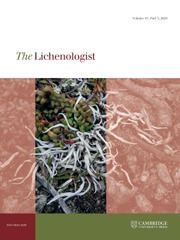Article contents
Visualized photosynthetic characteristics of the lichen Xanthoria elegans related to daily courses of light, temperature and hydration: a field study from Galindez Island, maritime Antarctica
Published online by Cambridge University Press: 08 September 2005
Abstract
Diurnal courses of photosystem II (PS II) activity of Xanthoria elegans were continuously monitored using a novel technique of chlorophyll fluorescence imaging in the field (maritime Antarctica) over a period of 7 days. The lichen specimens grew on rock surfaces in a north-facing coastal area of Galindez Island (Argentine Islands). A portable fluorometer FluorCam equipped with a CCD camera and image analysis software was placed over a thallus so that false colour images of FV/FM and quantum yield of photochemical processes in PS II (ΦII) distribution over the thallus could be taken over the course of a day. Simultaneously, microclimatic parameters of the habitat were recorded: air and thallus temperatures, relative air humidity, PPFR (photosynthetic photon fluence rate) and global radiation. Photosynthetic processes in X. elegans were activated by rainfall or water from melting snow. After thallus hydration, FV/FM and ΦII gradually decreased from their maximum values due to evaporation and progressive loss of water from the thallus. Chlorophyll fluorescence imaging showed that the thallus dehydration started from the margins and moved towards the central thicker thallus zones. These zones exhibited higher activity of PS II than the margins throughout the day. The rate of inhibition of photosynthetic processes in PS II was faster at the margins than in the centre of the thallus. Dependence of ΦII on thallus water potential (WP) was investigated during gradual dehydration under laboratory conditions. After a decrease in WP from zero to −7 MPa, X. elegans exhibited only a 13·8% decrease in ΦII from its maximal value. Within the range of WP of from −8 to −20 MPa, the ΦII decrease was more rapid reaching the critical point (ΦII=0) at WP of approximately −25 MPa. Chlorophyll fluorescence imaging and WP measurements showed that X. elegans is capable of maintaining detectable photosynthetic activity even at extremely low WP. Based on our microclimatological data, X. elegans may be photosynthetically active under field conditions for several hours after being wetted by rain or snowfall. It is suggested that chlorophyll fluorescence imaging is a powerful technique, transferable to field conditions and capable of visualizing heterogeneity of photosyntetic processes over a lichen thallus subjected to periodic dehydration.
- Type
- Research Article
- Information
- Copyright
- © British Lichen Society 2005
- 36
- Cited by




